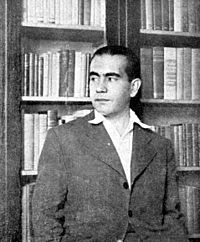Erico Verissimo facts for kids
Quick facts for kids
Érico Lopes Verissimo
|
|
|---|---|

Verissimo in 1940
|
|
| Born | December 17, 1905 Cruz Alta |
| Died | November 28, 1975 (aged 69) Porto Alegre |
| Occupation | novelist, short story writer |
| Nationality | Brazilian |
| Period | 1933-1975 |
| Literary movement | Modernist |
| Children | Luis Fernando Verissimo |
Érico Lopes Verissimo (born December 17, 1905, died November 28, 1975) was a very important Brazilian writer. He was born in the state of Rio Grande do Sul. He wrote many books, including novels, short stories, and even books for children.
Contents
The Life of Érico Verissimo
Early Life and Challenges
Érico Verissimo's parents were Sebastião Verissimo da Fonseca and Abegahy Lopes Verissimo. His father came from a wealthy family in Cruz Alta. But during Érico's childhood, his family lost their money. Because of this, Érico could not finish secondary school. He had to start working to help his family.
Becoming a Writer
Érico first tried to run a drugstore in Cruz Alta, but it was not successful. In 1930, he moved to Porto Alegre. He wanted to make a living only by writing. In Porto Alegre, he met many famous writers like Mário Quintana and Augusto Meyer.
In 1931, he got a job as a secretary for the Revista do Globo magazine. By 1933, he became the editor. He also helped the Editora Globo publishing house become famous across Brazil.
First Books and Family
Érico published his first book, Fantoches (which means "Puppets"), in 1932. It was a collection of short stories, often like short plays. The next year, he had his first big success with the novel Clarissa.
In 1931, Érico married Mafalda Volpe. They had two children: a son named Luis Fernando Verissimo, who also became a famous writer, and a daughter named Clarissa.
Time in the United States
In 1943, Érico and his family moved to the United States. He taught about Brazilian Literature at the University of California-Berkeley until 1945. Later, from 1953 to 1956, he worked as a director for the Department of Cultural Affairs at the Organization of American States in Washington, D.C.. This organization helps countries in North and South America work together.
Érico wrote about his time in the U.S. in books like Gato Preto em Campo de Neve ("Black Cat in a Snow Field"). He also wrote História da Literatura Brasileira ("History of Brazilian Literature"), which included some of his lessons from the UCLA.
His Greatest Work
His long story O Tempo e o Vento ("The Time and the Wind") is one of the most important Brazilian novels ever written. He wrote this historical story between 1949 and 1961. It tells the story of a family and a region over many years. Characters like Ana Terra and Capitão Rodrigo became very popular with readers.
Some of his books, including Time and the Wind and Noite ("Night"), were translated into English.
Later Works and Legacy
In 1965, Érico Verissimo published O Senhor Embaixador ("His Excellency, the Ambassador"). This book looked at the problems in Latin America.
In 1971, he wrote Incidente em Antares ("Incident in Antares"). This novel uses fantasy to talk about Brazilian politics. In the story, dead bodies rebel during a gravediggers' strike in a made-up city.
Érico Verissimo had a heart attack in 1975. He was working on the second part of his autobiography called Solo de Clarineta ("Clarinet Solo"). He also planned another novel. Sadly, he could not finish them. He passed away in 1975.
Érico Verissimo is remembered as one of Brazil's most important writers. His son, Luis Fernando Verissimo, also became a well-known writer.
Érico Verissimo's Books
His books have been collected and published many times. They have also been translated into many languages around the world.
Short Stories
- Fantoches ("Puppets")
- As mãos de meu filho ("My Son's Hands")
- O ataque ("The Attack")
Novels
- Clarissa – 1933
- Caminhos Cruzados ("Crossed Paths") – 1935
- Música ao Longe ("Music From Afar") – 1936
- Olhai os Lírios do Campo ("Behold the Lilies of the Field") – 1938
- Saga – 1940
- O Resto É Silêncio ("The Rest is Silence") – 1943
- O Tempo e o Vento (The Time and the Wind"):
- O continente ("The Continent") – 1949
- O Retrato ("The Portrait") – 1951
- O Arquipélago ("The Archipelago") – 1961
- Noite ("Night") - 1954
- O Senhor Embaixador ("His Majesty, the Ambassador") – 1965
- O Prisoneiro ("The Prisoner") – 1967
- Incidente em Antares ("Incident in Antares") – 1971
Children's Literature
Érico Verissimo also wrote many books especially for younger readers!
- A vida de Joana d'Arc – 1935
- As Aventuras do Avião Vermelho – 1936
- Os Três Porquinhos Pobres – 1936
- Rosa Maria no Castelo Encantado – 1936
- Meu ABC – 1936
- As Aventuras de Tibicuera – 1937
- O Urso com Música na Barriga – 1938
- A Vida do Elefante Basílio – 1939
- Outra vez os três porquinhos – 1939
- Viagem à aurora do mundo – 1939
- Aventuras no mundo da higiene – 1939
- Gente e bichos – 1956
Travel Books
- Gato Preto em Campo de Neve – 1941
- A Volta do Gato Preto – 1946
- México – 1957
- Israel em Abril – 1969
Autobiographies
- Solo de Clarineta – Memórias (Volume I) – 1973
- Solo de clarineta – Memórias (Volume II) – 1976 (published after he passed away)
Essays and Biographies
- Brazilian Literature: an Outline – 1945
- Mundo velho sem porteira – 1973
- Breve história da literatura brasileira
- Um certo Henrique Bertaso – 1972
See also
 In Spanish: Érico Veríssimo para niños
In Spanish: Érico Veríssimo para niños

